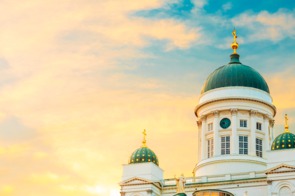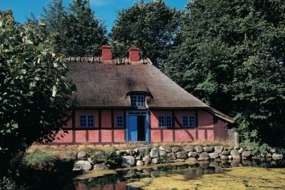
14 June
Setting sail from Copenhagen
With a history that dates back to 1043, this small city is full of historic landmarks, significant buildings and interesting sights and museums. It is of course also a history that sits alongside the height of modern Danish design. It is great to explore on foot, by bicycle or by water. Be sure to visit Amalienborg Palace and to walk down the famed shopping street (Strøget). The pretty harbour of Nyhavn is a great location to stop for coffee or lunch and watch the world go by. And of course highlights include the Tivoli Gardens, and the (surprisingly) tiny statue of The Little Mermaid.


Our tip
Copenhagen boasts some of the world’s best restaurants, so plan your visit and book ahead to get a real taste of Denmark. Really – they book up fast!
15-16 June
Germany: Warnemünde (Rostock)

The old Hanseatic port of Rostock was heavily damaged in the Second World War, though attractive enclaves of historic architecture remain. The little village of Warnemünde, a suburb of Rostock, is home to one of the most appealing beaches on the Baltic coast. An excursion inland to Berlin is a popular option, though it's around 150 miles each way.
17 June
Sweden: Karlskrona
18 June
Sweden: Visby

The charming UNESCO-listed town of Visby is the capital of Gotland, the largest island in the Baltic. The photogenic cobbled streets and ruined Gothic churches are a reminder of the island’s fascinating history, invaded by both Germans and Danes and decimated by the Black Death in the 14th century.
19 June
Åland Islands: Mariehamn

Mariehamn is the capital of the Åland Islands, a Swedish-speaking archipelago that actually belongs to Finland, situated halfway between Stockholm and Helsinki. The gentle pace of island life and the unique blend of Finnish, Swedish and Russian culture makes this an intriguing place to spend some time.
20 June
Finland: Vaasa

The city of Vaasa, on Finland’s west coast, lies just 50 nautical miles from Sweden, and nearly a quarter of the population speak Swedish as their first language. You can learn more about the history of Vaasa at the Museum of Old Vaasa, while just offshore lies the beautiful Kvarken Archipelago, a UNESCO World Heritage Site.
21-22 June
Finland: Kemi
23 June
Sweden: Lulea

24 June
Sweden: Sundsvall
25-26 June
Sweden: Stockholm

The buzzing city of Stockholm is the capital of Sweden. Many sights will delight; the busy waterfront, the cobbled streets in the Old Town, and the museums, palaces, gardens and galleries. And of course, just 20 minutes away, its archipelago of 30,000 islands offers a totally different experience.
27-28 June
Finland: Helsinki

Finland’s lovely capital Helsinki is a maritime city, with the sea on three sides and almost 100 kilometres of shoreline, as well as around 300 islands. Its contemporary architecture and focus on modern design sit surprisingly well alongside its four hundred year history.
29 June
Finland: Kotka
30 June
Estonia: Tallinn

The historic harbour city of Tallinn in Estonia is really quite captivating. Just the perfect size to explore on foot, its medieval (and UNESCO listed) town centre, with its cobblestone streets and a busy Town Hall Square, is the perfect introduction to Estonia’s rich history.
1 July
Estonia: Saaremaa

The Estonian island of Saaremaa is one of the Baltic’s best kept secrets, a timeless landscape of spruce forests, windmills and sleepy little villages. The island’s capital, Kuressaare, is a popular spa resort and is home to an impressive medieval castle.
2 July
Latvia: Riga

Riga, Latvia’s charming capital, is a highlight of any Baltic itinerary. The compact Old Town delights with its winding lanes and elegant spires, and the city is also home to one of Europe’s most impressive ensembles of Art Nouveau architecture.
3-4 July
Poland: Gdansk

The Baltic port of Gdansk occupies an important place in 20th century history; the first shots of World War II were fired at the Westerplatte naval base, and it was amongst the shipyards of Gdansk that the Solidarity movement was born in the 1980s.
5 July
Denmark: Ronne (Bornholm)

The ruggedly handsome island of Bornholm lies way out in the Baltic, closer to Sweden and Poland than the Danish mainland. It’s the sunniest place in Denmark, known for its intriguing rundekirke (round churches), sleepy fishing villages, traditional smokehouses and fantastic foodie scene.
6-7 July
Poland: Szczecin
Germany: Kiel
9-10 July
At sea
11 July
Norway: Trondheim

Trondheim’s wooden buildings look much as they would have done in the Middle Ages, rebuilt in the same style and layout throughout history. Here also Norway's national sanctuary, Nidaros Cathedral, was built over the grave of St. Olav, Norway's patron saint, with parts dating back to the 12th century.
12 July
Norway: Ålesund

When Ålesund was destroyed by fire in 1904, the German Kaiser Wilhelm II agreed to foot the bill to rebuild it. The result was the stunning Art Nouveau architecture that you see today, which blends elements of the German 'Jugendstil' with Viking flourishes.
13 July
Norway: Stavanger

Stavanger originally grew rich from its fishing industry, though these days it’s Norway’s oil boom that is powering the city’s economic growth. In spite of this modern gold rush the historic centre of Stavanger retains its charm, and the spectacular Lysefjord is within easy reach of the city.
14 July
Norway: Kristiansand

You might not expect to find a beach resort in Norway, but the sunny city of Kristiansand is where Norwegians go for a spot of fun by the seaside. There are plenty of family-friendly attractions, including a zoo, and it’s also a good base for exploring the pretty fishing villages of the south coast.
15-16 July
Norway: Oslo

The intriguing city of Oslo, Norway’s capital, has so much to offer, from the open air Norwegian Folk Museum to the amazing Vigeland sculpture park, and from the Holmenkollen Ski Museum to the Munch Museum’s collection of memorable paintings. History, art and culture are what defines this lovely city.
17 July
Sweden: Lysekil

The town of Lysekil is situated at the mouth of the Gullmarsfjord on the west coast of Sweden, on a coastline characterised by red granite cliffs and scattered islands. Highlights include the excellent Havets Hus aquarium and the charming streets of the compact Old Town, the Gamlestan
18 July
Denmark: Aalborg

Aalborg, Denmark’s fourth largest city, sits towards the northern tip of the Jutland peninsula, bisected by the Limfjord. It’s an important industrial centre and university town, with a recently revitalised waterfront area and a small but picturesque old town.
19 July
Sweden: Helsingborg

The Swedish port of Helsinborg occupies a strategic position at the narrowest point of the Öresund, the body of water that separates Sweden from Denmark. Sights include the impressive medieval Kärnan tower, and it’s a short ferry ride across the Öresund to the Danish city of Helsingør, home of Hamlet’s famous Kronborg Castle.
19-20 July
Arriving in Copenhagen


Don't miss
We love the open air museum, the Frilandsmuseet, just north of the city, housing more than 50 farms, mills and houses from the mid 17th to the mid 20th centuries.
Your home from home



What we love
These four boutique style sister ships carry just 684 guests apiece, with a comfortable, relaxed country house style and plenty of intimate corners. We love the alternative restaurants - Oceania is rightly renowned for great food - and the pretty little library up on deck 10.
| Capacity | 684 Guests |
|---|---|
| Crew | 400 International Staff |
| Style | On Oceania it's all about the time spent ashore, so back on board it's relaxed and unpretentious, with no dressing up. Open seating throughout creates an atmosphere which is friendly and sociable. |
| Inclusions |
|
Tailor-make your trip

Two nights in Copenhagen
Excellent super modern hotels abound, but our favourite for comfort and value is 71 Nyhavn, overlooking the harbour front.

Around Copenhagen
Travel out of the city to North Zealand to see the renaissance Frederiksborg Castle, and Hamlet’s Kronborg Castle at Elsinore.









